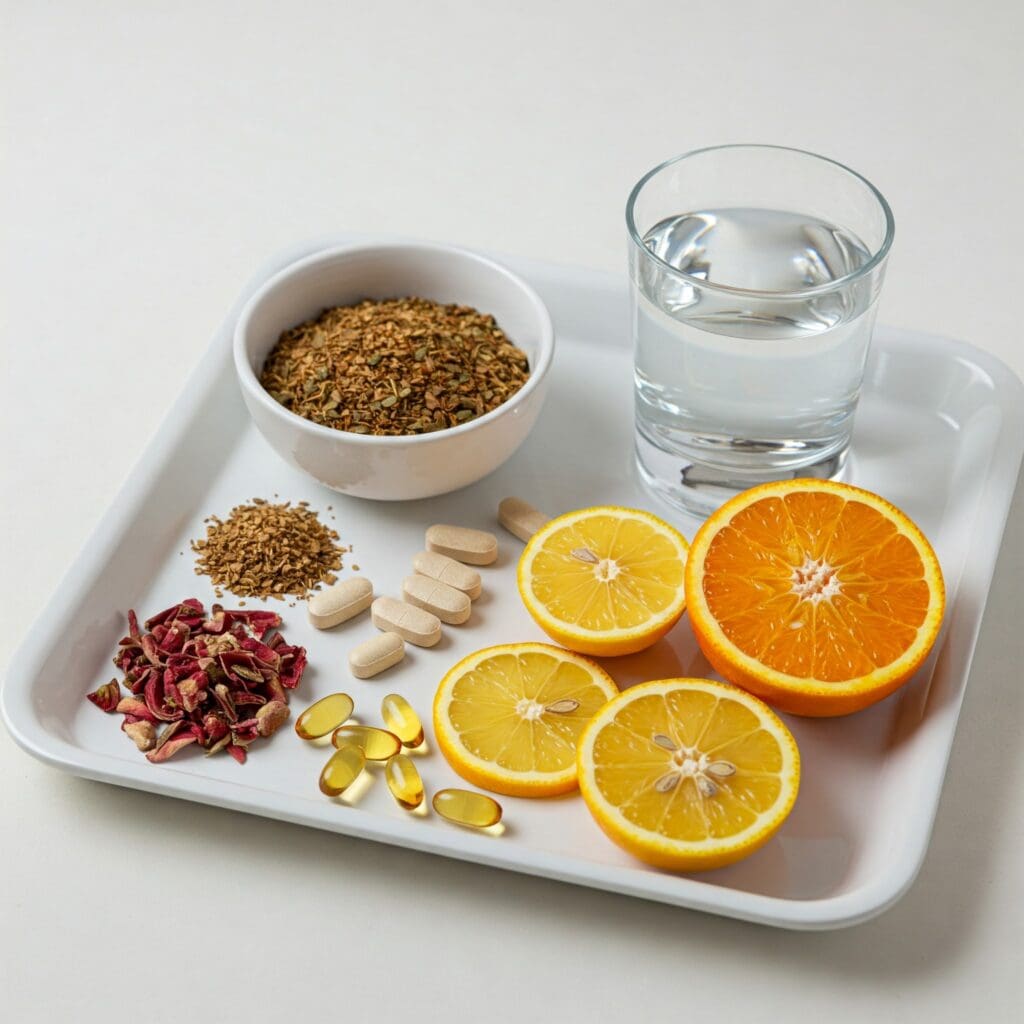Understanding Cortisol and Its Role in Weight, Hormones, and Stress
Cortisol, often referred to as the “stress hormone,” is essential for survival, playing a vital role in our body’s response to stress, metabolism, blood sugar regulation, and inflammation control. However, chronic stress can elevate cortisol levels beyond what is biologically optimal, leading to symptoms such as fatigue, irritability, weight gain, and particularly the development of stubborn belly fat. Prolonged high cortisol levels can also disrupt hormonal balance, suppress immunity, and impair digestion. This makes understanding how to implement a sustainable cortisol reducing diet plan not only valuable for stress management but essential for long-term health and wellness.
You may also like: The Best Supplements for Weight Loss: Natural Vitamins, Herbs, and Products That Help Women and Men Burn Fat Safely
The key to managing cortisol naturally lies in supporting the body’s own ability to regulate stress hormones. This is where a scientifically informed cortisol detox diet comes into play. Unlike extreme or restrictive detox plans, a cortisol-focused dietary approach prioritizes balance, nourishment, and anti-inflammatory foods that support adrenal function, gut health, and metabolic resilience. While stress is inevitable, its biological effects can be softened through mindful nutritional interventions that target cortisol regulation at its root.

Core Principles of a Cortisol Detox Diet
At the heart of any effective cortisol detox diet is a focus on stabilizing blood sugar, reducing inflammation, and nurturing the gut-brain axis. Frequent blood sugar spikes and crashes are known to trigger cortisol release, which is why consistent, balanced meals form the cornerstone of this approach. Each meal should ideally contain a source of quality protein, fiber-rich complex carbohydrates, and healthy fats, which together slow digestion and help prevent cortisol-stimulating glycemic swings.
Equally important is the emphasis on anti-inflammatory foods such as leafy greens, omega-3 rich fatty fish, berries, and fermented foods. These selections help lower systemic inflammation and promote healthy digestion, which plays a critical role in hormone detoxification. As part of a comprehensive cortisol diet plan, minimizing processed foods, added sugars, caffeine, and alcohol can significantly reduce the load on the adrenal system and promote hormonal balance. Hydration also plays a subtle yet crucial role in cortisol regulation, as even mild dehydration is known to elevate stress hormones.
Additionally, mindful eating practices—like chewing slowly, eating in a relaxed environment, and avoiding multitasking during meals—can have a profound effect on cortisol levels by shifting the body out of fight-or-flight mode and into a parasympathetic, rest-and-digest state. These practices are often overlooked but are critical for ensuring the effectiveness of any digesti plan cortisol strategy.

Nutritional Strategies That Naturally Lower Cortisol
In addition to overall dietary patterns, specific nutrients have been shown to directly impact the production and clearance of cortisol. Magnesium is one of the most well-researched examples, as it plays a central role in the HPA (hypothalamic-pituitary-adrenal) axis and can reduce the intensity of the stress response. Foods rich in magnesium, such as pumpkin seeds, avocados, spinach, and dark chocolate, should be included regularly in a cortisol reducing diet plan.
Vitamin C also plays a supportive role by modulating adrenal function and enhancing cortisol clearance. Citrus fruits, bell peppers, and cruciferous vegetables like broccoli are excellent natural sources of this vitamin. Likewise, B vitamins—particularly B5 and B6—are essential for adrenal health and energy metabolism, making foods like eggs, legumes, and whole grains critical to the success of a cortisol diet plan.
Adaptogenic herbs such as ashwagandha, rhodiola, and holy basil are often incorporated into cortisol detox diet protocols for their ability to modulate the stress response and promote homeostasis. While supplements can offer convenience, these herbs can also be infused into teas, added to smoothies, or included in tincture form as part of a personalized digesti plan cortisol strategy that supports both adrenal and digestive function.

Identifying Foods That May Trigger Elevated Cortisol
Knowing what to eat is only half the equation. Equally important is recognizing what foods and habits may be sabotaging your cortisol balance. Highly refined carbohydrates, sugary snacks, and energy drinks are some of the most common dietary culprits. These items cause rapid blood sugar elevation followed by a crash, which in turn prompts the adrenal glands to release cortisol to stabilize glucose levels. Chronic reliance on caffeine, especially when consumed on an empty stomach or in excess, can also stimulate cortisol production and exacerbate anxiety or insomnia.
Processed meats, deep-fried foods, and those high in omega-6 fats (such as many commercial vegetable oils) contribute to chronic inflammation and indirectly increase cortisol levels by burdening the immune system. Furthermore, restrictive diets that cut calories too drastically or eliminate entire food groups can place the body under perceived starvation stress, which ironically increases cortisol rather than lowering it.
The success of any cortisol reducing diet plan lies in both nourishment and avoidance. Eliminating known cortisol-triggering foods while embracing whole, nutrient-dense meals ensures that the adrenal glands are supported rather than taxed. A well-structured cortisol detox diet creates an internal environment where hormonal balance is restored rather than disrupted.
Sample Framework for a Cortisol Diet Plan
While personalization is key, a general cortisol diet plan might begin with a protein-rich breakfast such as scrambled eggs with leafy greens and avocado on sprouted grain toast. This type of meal helps blunt the morning cortisol surge and provides sustained energy. Mid-morning snacks like a handful of almonds or Greek yogurt with berries continue the trend of steady blood sugar and nutrient delivery.
Lunch should feature a mix of anti-inflammatory foods such as wild-caught salmon, quinoa, and a colorful vegetable medley dressed in olive oil and lemon juice. A herbal tea such as chamomile or holy basil can aid digestion and promote calmness during the afternoon. Dinner may include lean turkey or lentils, roasted sweet potatoes, and steamed broccoli. An evening ritual of magnesium-rich pumpkin seeds or a banana with almond butter can further support the cortisol clearance that naturally occurs during sleep cycles.
This sample digesti plan cortisol outline prioritizes satiety, micronutrient density, and digestive ease. It highlights the importance of aligning food intake with the body’s circadian cortisol rhythm, a concept increasingly supported by chrono-nutrition research. These food choices also promote liver detoxification pathways, which are critical for hormone metabolism and cortisol balance.
Lifestyle Factors That Complement a Cortisol Detox Diet
Beyond food, lifestyle interventions are necessary to truly optimize any cortisol detox diet. Sleep hygiene plays a foundational role. Inadequate or poor-quality sleep is a major contributor to elevated cortisol levels and impaired glucose tolerance. Ensuring a consistent bedtime, limiting screen time before sleep, and using calming rituals like deep breathing or meditation can amplify the benefits of dietary strategies.
Regular, moderate physical activity is another pillar of cortisol management. While high-intensity workouts may temporarily raise cortisol, consistent low to moderate-intensity exercise such as walking, yoga, or swimming can lower resting cortisol over time and improve overall stress resilience. The integration of movement into daily routines, especially when done in natural settings, has additional calming effects through exposure to natural light and fresh air.
Finally, psychological resilience practices—including journaling, therapy, or mindfulness training—help address the root causes of chronic stress. The synergy of a balanced cortisol reducing diet plan with restorative lifestyle practices creates a feedback loop of hormonal stability, improved digestion, and better mood regulation.
Frequently Asked Questions (FAQ) on Cortisol Diet Strategies
What are the biggest mistakes people make when starting a cortisol reducing diet plan?
One of the most common mistakes is cutting calories too drastically. While it may seem like a quick fix, severe restriction can backfire and actually raise cortisol levels instead of lowering them. A balanced cortisol reducing diet plan should prioritize nutrient density over calorie counting. Additionally, many people ignore the timing of meals, which is crucial for maintaining stable blood sugar—an essential factor in cortisol management. To optimize a cortisol detox diet, it’s also important to avoid inflammatory foods and focus on whole, unprocessed options that support digestive health within a targeted digesti plan cortisol approach.
Can a cortisol detox diet help improve mental clarity and focus?
Yes, many people report enhanced mental clarity when following a well-structured cortisol detox diet. This benefit is likely due to the reduction in systemic inflammation and blood sugar fluctuations that often impair cognitive performance. By incorporating adaptogenic herbs and foods rich in magnesium and B vitamins, a cortisol reducing diet plan can promote neurotransmitter balance. When combined with a supportive digesti plan cortisol protocol, this approach may also improve gut-brain communication—critical for reducing “brain fog.” The synergy between brain health and hormonal balance is a core reason why the cortisol diet plan can impact more than just weight.
How long does it take to see results from a cortisol reducing diet plan?
Results vary, but many individuals begin noticing improvements in energy, mood, and waist circumference within 2 to 4 weeks of starting a cortisol reducing diet plan. However, the full effects—especially in reducing cortisol belly fat—can take a few months of consistent application. A well-crafted cortisol detox diet includes long-term strategies rather than quick fixes, emphasizing sustained lifestyle changes. Incorporating a digesti plan cortisol approach that supports gut health also plays a pivotal role, as chronic digestive stress can keep cortisol levels elevated. Commitment and consistency are key, as intermittent efforts may hinder progress.
What is the best meal timing strategy for a cortisol diet plan?
The ideal cortisol diet plan incorporates meal timing that aligns with your circadian rhythm. Eating within an early 10- to 12-hour window supports both hormone regulation and digestive efficiency. Many experts recommend consuming a protein-rich breakfast within 90 minutes of waking to blunt the morning cortisol spike. This approach, when paired with a digesti plan cortisol strategy, helps improve nutrient absorption and reduces late-day stress cravings. Fasting too long can trigger cortisol surges, so structured, anti-inflammatory meals throughout the day are essential in any cortisol reducing diet plan.
How does a digesti plan cortisol framework enhance the effectiveness of a cortisol detox diet?
Digestive support is a game-changer when it comes to managing stress hormones. A digesti plan cortisol framework ensures that your gut microbiome is supported through probiotic foods, prebiotic fibers, and enzymes that aid in nutrient breakdown. When digestion is efficient, the body experiences less physiological stress, which contributes to lower cortisol output. This is why a successful cortisol detox diet isn’t just about what you eat—but how well your body processes it. Adding fermented foods, bone broth, and gentle herbal teas can optimize results within a cortisol reducing diet plan.
Which specific nutrients should be emphasized in a cortisol detox diet?
A successful cortisol detox diet emphasizes nutrients that directly support adrenal function, blood sugar regulation, and inflammation control. Key players include magnesium, vitamin C, B-complex vitamins, omega-3 fatty acids, and amino acids like L-theanine and glycine. These nutrients can be integrated into your cortisol reducing diet plan through whole foods such as leafy greens, fatty fish, nuts, seeds, and citrus fruits. A digesti plan cortisol strategy enhances absorption of these nutrients, ensuring they reach the tissues where they’re needed most. Without adequate intake of these micronutrients, even the best cortisol diet plan may fall short.
Can a cortisol reducing diet plan aid in reversing cortisol belly fat specifically?
Yes, one of the core benefits of a cortisol reducing diet plan is targeting visceral fat, especially around the abdomen. Cortisol belly is often resistant to typical weight loss strategies because it’s hormonally driven. A cortisol detox diet rich in fiber, healthy fats, and anti-inflammatory compounds can help rebalance the hormonal environment that promotes fat storage. When combined with a supportive digesti plan cortisol regimen, the body becomes more efficient at clearing excess hormones and reducing fat accumulation. Lifestyle stressors also need to be addressed in parallel for the best long-term results.
How do stress-eating patterns affect a cortisol diet plan?
Stress eating is one of the biggest saboteurs of a cortisol diet plan. Emotional eating spikes blood sugar and disrupts the hormonal feedback loop, leading to more cortisol release. Over time, this undermines the effectiveness of even the most carefully constructed cortisol reducing diet plan. Addressing the psychological roots of stress and incorporating mindful eating can dramatically improve compliance. Integrating calming rituals and adapting a digesti plan cortisol philosophy—such as slower meal consumption and gratitude practices—helps reset stress patterns at both the behavioral and physiological levels.
Are there lifestyle habits that enhance the effects of a cortisol detox diet?
Absolutely. Sleep quality, physical activity, and breathwork can significantly enhance the impact of a cortisol detox diet. Prioritizing 7–9 hours of restorative sleep helps reset your cortisol rhythm and enhances insulin sensitivity. Low- to moderate-intensity exercise supports fat metabolism and stress relief without overtaxing the adrenals. Combining these habits with a thoughtful cortisol reducing diet plan and digesti plan cortisol practices—like spacing meals evenly and avoiding eating on the go—yields better hormonal balance. Think of it as a holistic strategy rather than a one-dimensional dietary fix.
How does the cortisol diet plan evolve after the detox phase?
Post-detox, the cortisol diet plan should transition into a sustainable lifestyle rooted in whole, unprocessed foods and stress-aware living. You can gradually reintroduce certain foods while monitoring their effect on mood, energy, and digestion. A successful cortisol reducing diet plan becomes intuitive over time, with less focus on restriction and more on nourishment. Continuing to follow digesti plan cortisol principles—such as eating in relaxed settings and supporting microbiome diversity—helps prevent future cortisol dysregulation. The goal is not perfection, but resilience: building a body that handles stress without storing fat or burning out.
Conclusion: Designing a Holistic Cortisol Diet Plan for Long-Term Wellness
The pursuit of hormonal balance, better digestion, and fat loss is deeply intertwined with how we manage stress at both the physiological and lifestyle levels. A properly structured cortisol reducing diet plan offers a powerful, non-invasive method for lowering stress hormones, supporting detox pathways, and addressing common challenges like belly fat and fatigue. The success of a cortisol detox diet lies not in restriction but in restoring balance—providing the body with the nourishment it needs while removing the elements that interfere with natural hormone regulation.
Understanding how a thoughtful cortisol diet plan can be aligned with natural circadian rhythms, digestive health, and anti-inflammatory principles gives individuals the tools they need to thrive. Moreover, incorporating a personalized digesti plan cortisol approach ensures that each step supports not just cortisol balance, but also gut health, mood, and energy. Through consistent dietary choices and complementary lifestyle adjustments, long-term vitality and resilience are achievable without extremes.
adrenal fatigue recovery, stress hormone imbalance, anti-inflammatory diet plan, belly fat reduction foods, adaptogens for stress, cortisol-friendly meals, natural hormone balance, adrenal support nutrition, functional foods for stress, blood sugar and cortisol, magnesium-rich foods, circadian rhythm diet, gut-brain axis diet, mindful eating habits, herbal stress remedies, lifestyle changes for cortisol, holistic belly fat loss, foods that soothe digestion, emotional eating and stress, nutrition for stress resilience
Further Reading:
11 Natural Ways to Lower Your Cortisol Levels
Foods that lower cortisol and anxiety (with 3 day meal plan)
The Ultimate Expert-Approved Diet Plan for a Happier, Less-Stressed You
The information contained in this article is provided for general informational purposes only and is not intended to serve as medical, legal, or professional advice. While NewsHealthWatch strives to present accurate, up-to-date, and reliable content, no warranty or guarantee, expressed or implied, is made regarding the completeness, accuracy, or adequacy of the information provided. Readers are strongly advised to seek the guidance of a qualified healthcare provider or other relevant professionals before acting on any information contained in this article. NewsHealthWatch, its authors, editors, and contributors expressly disclaim any liability for any damages, losses, or consequences arising directly or indirectly from the use, interpretation, or reliance on any information presented herein. The views and opinions expressed in this article are those of the author(s) and do not necessarily reflect the official policies or positions of NewsHealthWatch.

